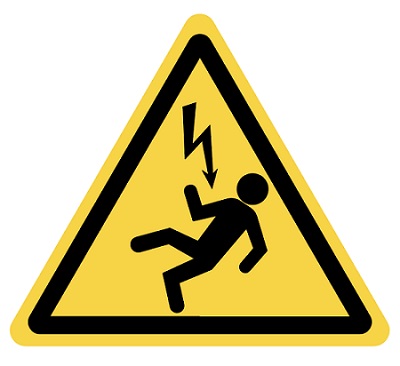
Safety Alert 90 - Electric Shock

The 4th year apprentice and tradesperson had started their day together on site and had completed a site specific risk assessment. The apprentice was then tasked with installing flexible duct for an exhaust fan where the ceiling had been removed ahead of the reinstallation of the ceiling. The tradesperson left the apprentice alone on site to complete this task (broad supervision) but did not ensure that the site was fully de-energised. The site was a domestic dwelling (house) that is being converted into a commercial premise. Selected circuits had been left energised to provide site power for the various trades working on the site.
The apprentice went ahead with the task, working through the open ceiling off a fibreglass ladder with electrical cables clipped to the beams around them. The apprentice had not checked the cables around his work area with his volt stick. Additionally, he had not carried out a lock out tag out procedure, as he and his tradesperson had deemed the work to be non-electrical.
The apprentice was installing the ducting into the small section of the roof when the duct made contact with an unterminated, energised cable hanging from the ceiling joists behind him. This caused the duct itself to become live and give the apprentice an electric shock through his hands, which were holding the ducting.
Root Cause
1. Job/System Factors:
- Inadequate supervision – broad supervision requirements for maintenance, alterations and additions to existing electrical installations state that you must only work under broad supervision when the site has been isolated and proven deenergised by the supervising electrical worker.
- Inadequate work practice – by the tradesperson for not completing the correct isolation procedure when working near live wiring or equipment, and for not involving the apprentice in the isolation process.
- Inadequate work procedures – all circuits should be de-energised prior to working within the ceiling space and the risk assessment in place did not include provisions for isolation.
2. Personal Factors:
- Lack of knowledge – on behalf of the apprentice regarding the correct isolation practice and procedures.
- Improper motivation – apprentices must complete the EGT RAC (Risk Assessment Checklist) or the host employer’s equivalent and must ‘test before you touch’.
Contributing Factors
- Inadequate or improper protective equipment – the apprentice was not wearing protective gloves.
- Inadequate leadership/supervision from the tradesperson – failure to deenergise all circuits before working in the roof space.
- Lack of knowledge – the apprentice wasn’t aware of the hazard due to the nature of the task (considered non-electrical work).
- Inadequate testing procedure – the circuit with the exposed live wire should never have been energised with an unterminated end.
Recommendations
- EGT apprentices are to ensure the “test before you touch” principles are followed prior to the commencement of all work activities.
- EGT apprentices must ensure that they DO NOT work in the vicinity of live parts.
- EGT apprentices should ensure circuits have been isolated by the tradesperson and participate in the process (i.e. follow the steps of isolation in the RAC).
- EGT apprentices must complete their personal risk assessment (RAC) or other approved personal risk assessment (e.g. Take 5) prior to the commencement of all work activities.
- EGT apprentices must ensure they wear PPE e.g. gloves.
- The Risk Assessment in place is to detail the isolation procedure step-by-step.
Feedback
For further information regarding this Safety Alert, please contact EGT on (08) 6241 6100 or speak with your Field Officer. Click here for a PDF version of this Safety Alert.












